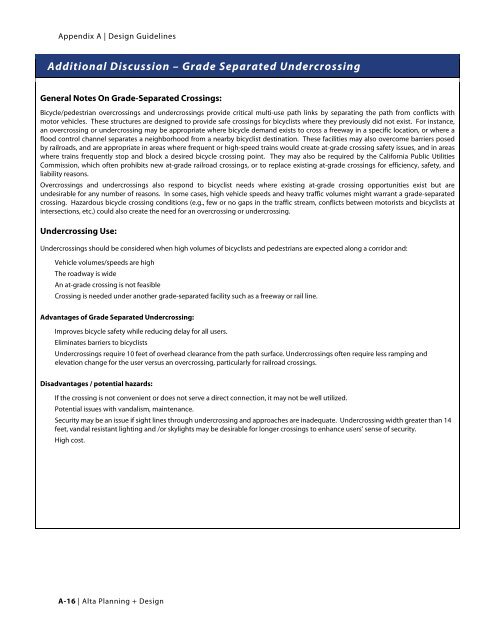City of Oxnard - Bicycle and Pedestrian Master Plan Appendices
City of Oxnard - Bicycle and Pedestrian Master Plan Appendices
City of Oxnard - Bicycle and Pedestrian Master Plan Appendices
Create successful ePaper yourself
Turn your PDF publications into a flip-book with our unique Google optimized e-Paper software.
Appendix A | Design Guidelines<br />
Additional Discussion – Grade Separated Undercrossing<br />
General Notes On Grade-Separated Crossings:<br />
<strong>Bicycle</strong>/pedestrian overcrossings <strong>and</strong> undercrossings provide critical multi-use path links by separating the path from conflicts with<br />
motor vehicles. These structures are designed to provide safe crossings for bicyclists where they previously did not exist. For instance,<br />
an overcrossing or undercrossing may be appropriate where bicycle dem<strong>and</strong> exists to cross a freeway in a specific location, or where a<br />
flood control channel separates a neighborhood from a nearby bicyclist destination. These facilities may also overcome barriers posed<br />
by railroads, <strong>and</strong> are appropriate in areas where frequent or high-speed trains would create at-grade crossing safety issues, <strong>and</strong> in areas<br />
where trains frequently stop <strong>and</strong> block a desired bicycle crossing point. They may also be required by the California Public Utilities<br />
Commission, which <strong>of</strong>ten prohibits new at-grade railroad crossings, or to replace existing at-grade crossings for efficiency, safety, <strong>and</strong><br />
liability reasons.<br />
Overcrossings <strong>and</strong> undercrossings also respond to bicyclist needs where existing at-grade crossing opportunities exist but are<br />
undesirable for any number <strong>of</strong> reasons. In some cases, high vehicle speeds <strong>and</strong> heavy traffic volumes might warrant a grade-separated<br />
crossing. Hazardous bicycle crossing conditions (e.g., few or no gaps in the traffic stream, conflicts between motorists <strong>and</strong> bicyclists at<br />
intersections, etc.) could also create the need for an overcrossing or undercrossing.<br />
Undercrossing Use:<br />
Undercrossings should be considered when high volumes <strong>of</strong> bicyclists <strong>and</strong> pedestrians are expected along a corridor <strong>and</strong>:<br />
Vehicle volumes/speeds are high<br />
The roadway is wide<br />
An at-grade crossing is not feasible<br />
Crossing is needed under another grade-separated facility such as a freeway or rail line.<br />
Advantages <strong>of</strong> Grade Separated Undercrossing:<br />
Improves bicycle safety while reducing delay for all users.<br />
Eliminates barriers to bicyclists<br />
Undercrossings require 10 feet <strong>of</strong> overhead clearance from the path surface. Undercrossings <strong>of</strong>ten require less ramping <strong>and</strong><br />
elevation change for the user versus an overcrossing, particularly for railroad crossings.<br />
Disadvantages / potential hazards:<br />
If the crossing is not convenient or does not serve a direct connection, it may not be well utilized.<br />
Potential issues with v<strong>and</strong>alism, maintenance.<br />
Security may be an issue if sight lines through undercrossing <strong>and</strong> approaches are inadequate. Undercrossing width greater than 14<br />
feet, v<strong>and</strong>al resistant lighting <strong>and</strong> /or skylights may be desirable for longer crossings to enhance users’ sense <strong>of</strong> security.<br />
High cost.<br />
A-16 | Alta <strong>Plan</strong>ning + Design
















